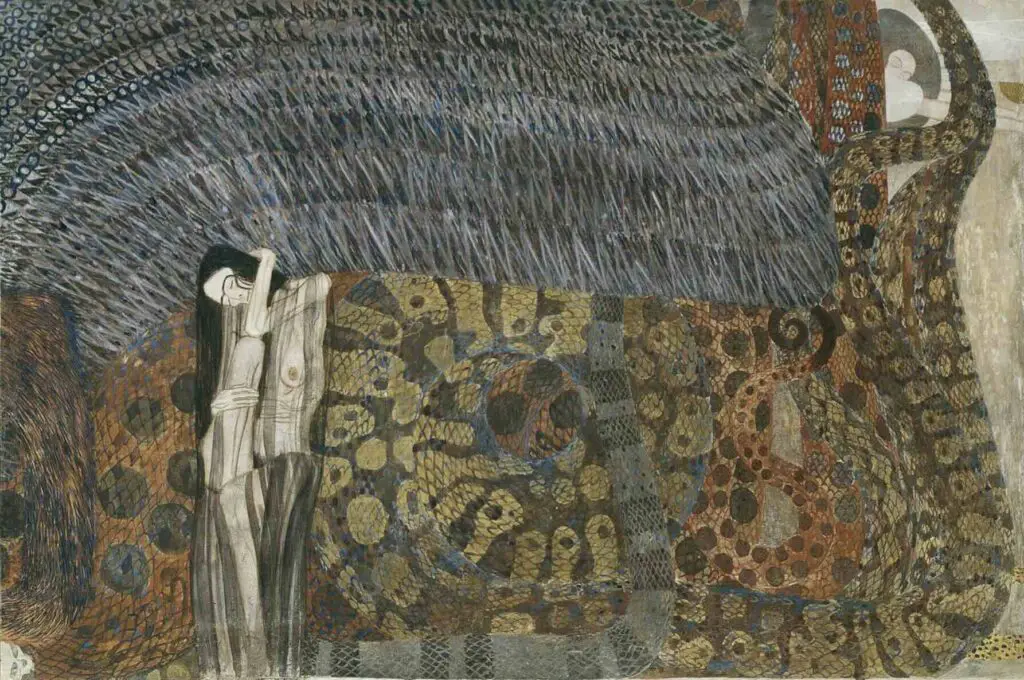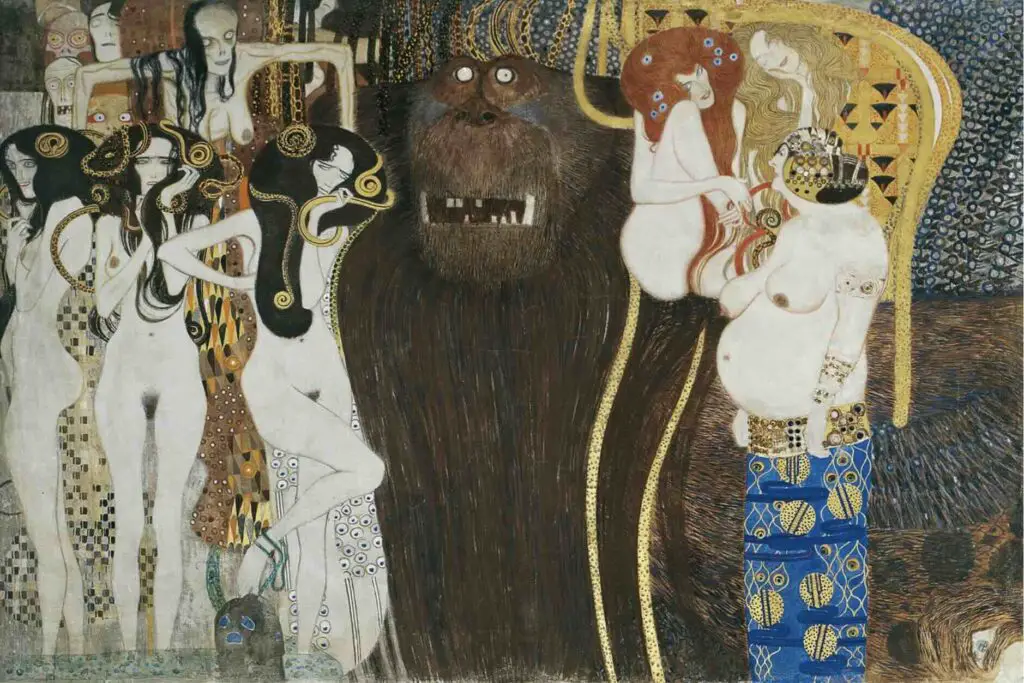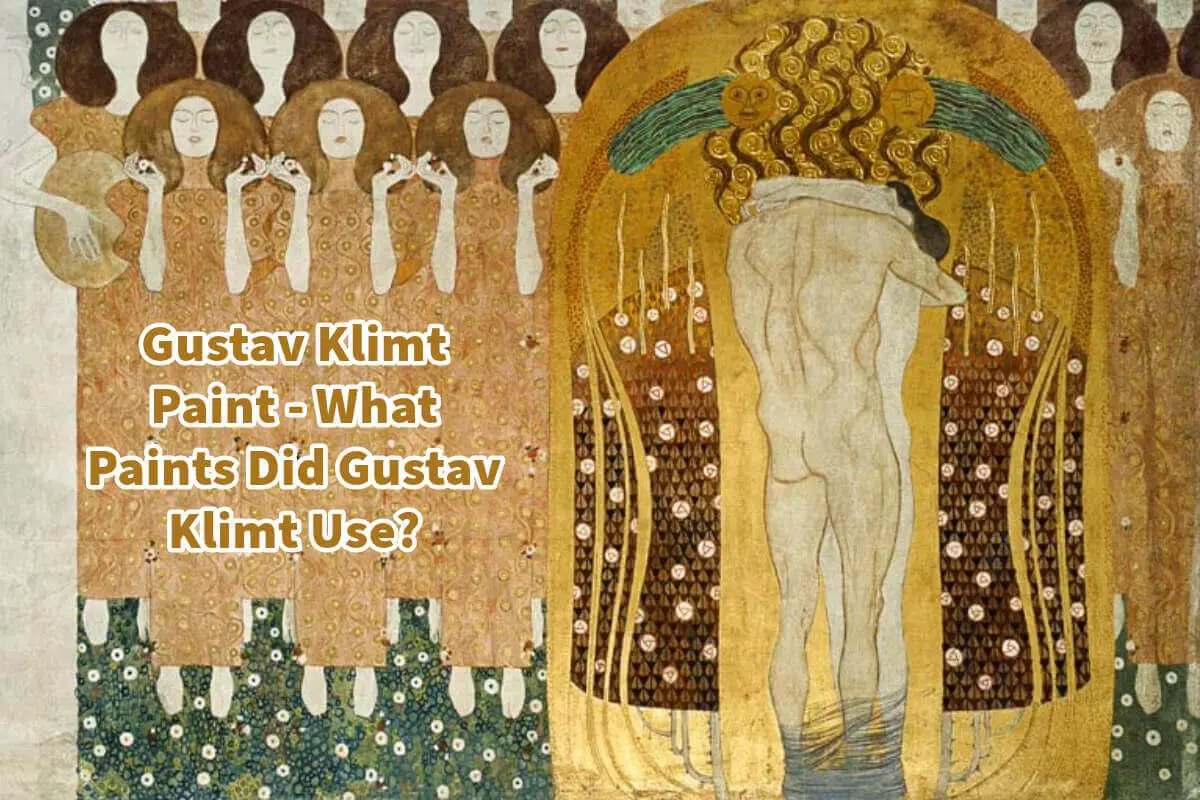Gustav Klimt, the renowned Austrian symbolist painter of the late 19th and early 20th centuries, left a lasting legacy of stunning and opulent artworks.
Gustav Klimt’s distinctive style is instantly recognizable, characterized by intricate patterns, symbolic themes, and lavish ornamentation. Gustav Klimt employed various paints and techniques to bring his visions to life. Read on as we delve into the paints that Gustav Klimt used to create his masterpieces, providing insights into his artistic process and choices.
Table of Contents
- Gustav Klimt’s Artistic Alchemy: The Secrets Of His Painting Techniques And Gold Leaf Magic
- The Quest For “Golden” Brilliance And Gustav Klimt
- The Beethoven Frieze: A Complex Mix Of Materials
- Related Questions
Gustav Klimt’s Artistic Alchemy: The Secrets Of His Painting Techniques And Gold Leaf Magic
Gustav Klimt, an Austrian symbolist painter renowned for his captivating and opulent artworks, left an indelible mark on the world of art during the late 19th and early 20th centuries.
One of his distinctive hallmarks was his intricate use of materials and techniques that lent his creations a unique depth and luminosity.
Read on as we embark on a fascinating journey into Klimt’s world of paint, particularly his use of casein paint, and explore his mastery of gold leafing. These techniques added a dimension of brilliance and luxury to his paintings, making them some of the most celebrated in art history.
Understanding Casein Paint
Casein paint is a lesser-known but intriguing medium that Gustav Klimt employed in his artistic endeavors. Casein, derived from the Latin word “caseus,” meaning cheese, is a milk-based paint binder.

It is one of the examples of Gustav’s painting, which used a Casein.
This type of paint is created by mixing pigments with casein glue, often derived from the curds of cow’s milk. Casein paint is favored for its versatility and compatibility with various surfaces, including canvas panels, illustration boards, paper, wood, and masonite.
One notable characteristic of casein paint is its reworkability, allowing artists to adjust and change even after the paint has dried. This feature makes casein an excellent choice for underpainting, providing a flexible foundation for subsequent layers of paint.
Klimt’s Unique Application Of Casein Paint
Gustav Klimt’s use of casein paint was not limited to traditional canvases but extended to more unconventional surfaces. He experimented with applying casein paint on dried plaster in his quest for artistic innovation.
This technique had a distinctive effect on the colors, rendering them matte. The choice of casein paint and dried plaster contributed to the brilliant and radiant quality of his murals’ gold and silver elements.
Gustav Klimt’s Use Of Oil Paints
Oil paints were a fundamental component of Klimt’s artistic toolbox. These paints consist of pigments suspended in oil, typically linseed oil. Klimt appreciated the versatility and luminosity of oil paints, which allowed him to achieve vibrant colors on his canvases.
Oil paints also offered a slow drying time, allowing the artist to blend and manipulate the colors on the canvas.
The Quest For “Golden” Brilliance And Gustav Klimt
Klimt was famously called the “Golden Klimt” due to his affinity for incorporating precious metals, particularly gold leaf, into his artworks. The intention behind using gold leaf was to achieve a planar effect that exuded luxury and brilliance.

Klimt’s fascination with gold was not just a superficial choice but a deliberate artistic statement that aimed to elevate his paintings to luxury and extravagance.
Gold Leafing: A Glimpse Into Klimt’s Process
Gold leafing, or gilding, is an age-old technique that involves applying thin sheets of actual gold to a surface, often using an adhesive or varnish. In Klimt’s case, gold leafing was pivotal in pursuing luxury and three-dimensionality in his artworks.
The Beethoven Frieze: A Complex Mix Of Materials
One of Gustav Klimt’s most complex and celebrated works, the Beethoven Frieze, showcases his mastery of materials and ability to create visually stunning compositions. In this monumental artwork, Klimt used a variety of substances, including casein paint, applied stucco, and gilding.

It is one of the examples of Gustav’s painting, which used a Casein.
However, this list only scratches the surface of the materials employed by Klimt in response to Max Klinger’s Beethoven statue, which featured a complex mix of materials.
Beyond casein paint and gilding, Klimt’s artistic arsenal included cut opaline glass buttons, transparent stained glass set into metal, small mirrored plates, mother-of-pearl buttons, and hollow brass rings used as applications.
These diverse materials allowed Klimt to add intricate details and layers to his paintings, creating a multi-dimensional visual experience for viewers.
Flatness Vs. Three-Dimensionality And Gustav Klimt
Klimt’s use of fresco-secco, a technique where dry pigments are applied to dry plaster, added a unique dimension to his paintings. This approach deviated from the prevalent method during the Ringstrasse era, where oil paintings on canvas were typically pasted onto walls using the marouflage technique.
The Beethoven Frieze, in particular, illustrates Klimt’s ability to use gilding to emphasize essential elements of his compositions, enhancing the three-dimensional effect of the gilded materials. This tactile approach suggests that he may have employed the technique of mordant gilding to achieve the desired depth and texture.
Gustav Klimt’s mastery of materials and techniques, including casein paint and gold leafing, elevated his artworks to unprecedented luxury and brilliance. The deliberate choice of these materials was not merely aesthetic but also conveyed profound artistic statements and emotions.
We gain a deeper appreciation for his unparalleled creativity and ability to push artistic expression’s boundaries as we explore Klimt’s world of paint and gold leaf magic. His artworks continue to captivate and inspire, reminding us that art, at its core, is an alchemical blend of technique, innovation, and emotion.
Klimt’s legacy is a testament to the enduring power of artistic exploration and the timeless allure of luxury and brilliance in art.
Anita Louise Art is dedicated to art education, great artists, and inspiring others to find and create their art. We love art that uplifts and inspires. #ArtToMakeYouSmile! #ArtToMakeYouHappy!
If you want to see any of my art, you can find out more by clicking here. If you are interested in what inspires me and my paintings, you can discover more by clicking here.
We have a free newsletter and would love you to be part of our community; you can subscribe to the newsletter by clicking here. If you have any questions, I would be happy to talk to you. You can reach me, Anita, by clicking here.
Subscribe to our Anita Louise Art YouTube Channel, filled with great videos and information by clicking here.
Join us for our podcast “5 Minutes With Art.” Spend just 5 minutes a week with us to discover and learn about great art and artists. You can find out more about our podcast by clicking here.
Related Questions
Unlocking The Secrets Of Gustav Klimt’s Iconic Kiss
The Kiss is one of Gustav Klimt’s most celebrated artworks; it was painted from 1907 to 1908. The painting is filled with intricate details and gold leaf. The Kiss by Gustav Klimt depicts a couple locked in a passionate embrace, with the man kissing the woman on her cheek. The painting shows Gustav Klimt’s unique artistic style.
By clicking here, you can learn more by reading Unlocking The Secrets Of Gustav Klimt’s Iconic Kiss.
Gustav Klimt’s Paintings: An Intimate Glimpse Into His Genius
Gustav Klimt is widely regarded as one of the most influential artists of the 20th century. His innovative and daring approach to art and unique style and vision have made him an icon in modern art. Klimt’s paintings are celebrated for their sensuality, symbolism, and intricate details, which have captivated audiences for over a century.
By clicking here, you can learn more by reading Gustav Klimt’s Paintings: An Intimate Glimpse Into His Genius.
The Timeless Legacy Of Gustav Klimt’s Paintings
Gustav Klimt was a groundbreaking Austrian artist whose work continues to captivate audiences worldwide. His bold and innovative approach to art and his use of symbolism and sensuality have made him one of the most iconic artists of the modern era. Klimt’s legacy has profoundly influenced the art world and continues to inspire artists today.
By clicking here, you can learn more by reading The Timeless Legacy Of Gustav Klimt’s Paintings.


